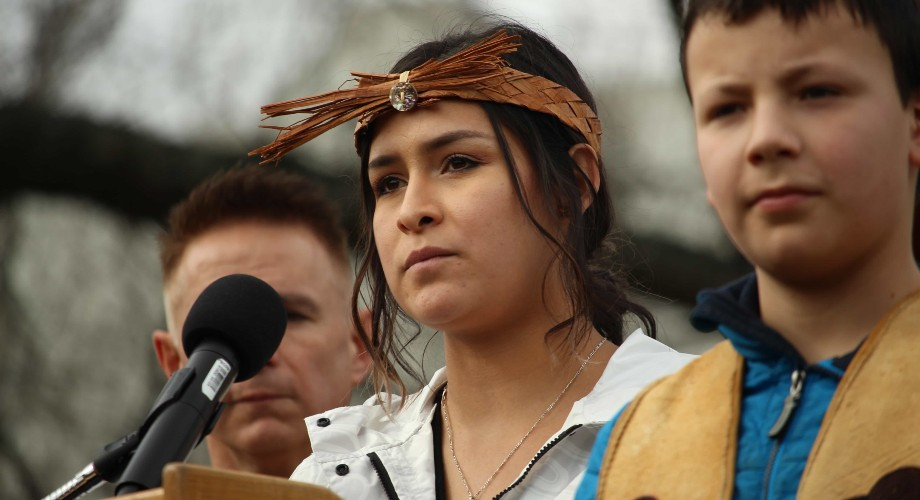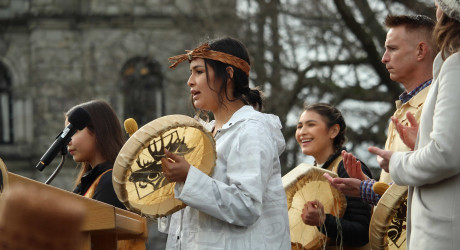In the Blog
How Moose Hide Campaign founder Raven Lacerte is spreading medicine across Canada

Photo by Moose Hide Campaign
Let’s travel back to March of 2020, a time I know most would rather not revisit, but bear with me. Midway through the month, the COVID-19 pandemic evolved from a seemingly distant news event to an everyday reality for Canadians, and concern over the safety of individuals trapped in violent home environments rose. Between March and June of 2020 alone, calls to the police related to domestic disturbances in Canada saw a spike of 12%. For many—including myself—the realization that so many people across the nation were regularly grappling with domestic violence was new. For the first time, I and many were seriously considering matters that The Moose Hide Campaign has been drawing public attention to since 2011.
Founded by Raven Lacerte at the age of 16 and her father Paul, The Moose Hide Campaign aims to end violence directed at women and children. To do so, it seeks the involvement of men and boys, providing them the tools to understand and model positive masculinity. By connecting men to local charities that provide a deeper understanding of their emotions and domestic relationships, the campaign ultimately aims to “inspire men to become involved in the movement to end violence.”
Based out of Victoria, B.C., the campaign’s work has spread all across the country, with over 1,000,000 moose hide pins distributed to Canadians since the organization’s founding. These pins demonstrate an understanding of the organization’s daily commitment and reminder to speak out against abuse.
When I spoke with Raven, now 26, about the birth of the organization, she explained to me where the inspiration for The Moose Hide Campaign originated. As one might expect, the story begins with a moose.
“[My dad and I] were out hunting along the Highway of Tears…and we were lucky enough to get a moose that year,” Raven told me, stressing how fortunate she felt to have gone on a successful hunting mission and make use of the resources provided by the moose. As she cleaned out the animal, she and her father found themselves talking about the disproportionate rate of violence committed against Indigenous women and children, and wondering what they could do to help. Considering that Indigenous women are 3.5 times more likely to experience violence than non-Indigenous women, and that over 4,000 Indigenous women are considered murdered or missing as of 2021, it is easy to understand why Raven and her father felt the need to discuss such a difficult subject.
“We were trying to figure out what our family could do to be part of the solution and offer some love and some medicine,” Raven said. It was then that the idea came to life: Raven, her father and her sisters would “tan up that moose hide and cut it up into a bunch of little squares, and ask people to wear that as their everyday commitment to not do violence in their lives.”
To the Lacertes, moose hide is not only a reminder of the day the campaign came to life, but of what the natural world has to offer. Raven explained, “We see our land as so beautiful and so full of medicine, and it just lifts us up every time we’re out there. And we thought that if we could offer just a little bit of that medicine, that people would wear that as their everyday commitment and reminder.”
Initially, the Moose Hide Campaign was simply a family project. Raven and her sisters cut up around 25,000 squares of moose hide and hand-wrote information cards to go along with each. Next, Raven handed out the squares and cards to anyone who was willing to have a conversation about violence directed towards Indigenous women and children. Did I mention she was only 16 at the time? When I imagine my 16-year-old self engaging with strangers, attempting to strike up a dialogue about the role of men in remedying violence against women and children, I don’t get very far. In all honesty, at 16, I didn’t have the guts to do anything like this. But not Raven.

Raven Lacerte at Moosehide Campaign Day 2020.
“It was really nerve-wracking. I just knew that I had good intentions in my heart, and my dad was there to help support me in sharing all of the messages that we had of love and hope and safety,” she said, sharing what lay behind her motivation.
At its conception, the Moose Hide Campaign was intended to serve specifically Indigenous women. Yet Raven and her father soon realized that although the rates of crime and violence committed against Indigenous women are disproportionately high, Canadian women of all backgrounds are struggling to find safety. The campaign has since widened its scope and aims to better the lives of all Canadian women. “It’s really opened up since we first got this idea, and we’ve just been learning and growing along the way,” added Lacerte.
Part of what makes this organization so special is not only its goal to protect women, but that it does so by enriching the lives of men, too. Consider the Ten Men Challenge. First launched in mid-2016, each year, it encourages a group of 10 young men in Grades 9 to 11 to fast for a day. During the day, the Moose Hide Campaign “[invites] the community, the school, and everyone to come and lift up those 10 young men. We stand them up in front of their community, and their school and say, ‘This is what these 10 men have volunteered to do, they’re fasting for the day in an effort to end violence against women and children, deepen their commitment, deepen their understanding of the issue and commit to being those safe people in the community.’ And so, they stand there and make that commitment in front of everyone.”
Since the birth of Ten Men, the program has been run independently by schools all across Canada. As a truly grassroots organization, the Moose Hide Campaign relies upon the initiative of those who bring events like the Ten Men Challenge into their communities. “There’s a how-to guide [on runing the Ten Men Challenge] on our website and we’ve just been hearing about it after it’s done. I love that part of community ownership that people feel over this medicine,” Raven said.
Though the Ten Men Challenge only lasts one day, the collective decision of each group to take a public stance against violence is remarkable. As Raven explained to me, when fasting, “the veil gets really thin between our world and the spirit world” — allowing for possible interactions between the two.
As impressive as the Ten Men Challenge may be, it is but one of many programs and events run by the Moose Hide Campaign. Moose Hide Campaign Day, which took place virtually this past February, is yet another noteworthy stepping stone for the organization. Of course, with it being run online for the first time, things looked a little different than in past years.
“Normally, we would meet and do circles — healing circles — and it would just be an opportunity for people to share openly and honestly about what violence means to them in their lives: if they’ve experienced it, if they’ve witnessed it, if they’ve done it themselves, what their healing journey has looked like,” explained Raven. “And everyone comes together just as human beings. So, you leave your title at the door, you just come as a person and you share in this sacred circle.”
But as we all know, the pandemic changed the way many organizations operate, and Moose Hide Campaign Day was no exception. In place of the campaign’s typical healing circles and in-person gatherings, in its shift to online, the event was reduced to skill-building workshops, speaker sessions and opportunities to learn about Indigenous cultures. Though, that’s hardly a limited experience with this year’s turnout remaining strong, and a whopping 80,000 Canadians having registered. In order to raise the event’s accessibility, future Moose Hide Campaign Days will continue to offer virtual events in addition to the highly-anticipated return of in-person gatherings.
Whether it’s this or the Ten Men Challenge, all events run by the organization have a common thread: empowering participants to return to their everyday lives and affect positive change in their own communities. In fact, enabling individuals to create grassroots-level change is at the core of how the Moose Hide Campaign runs. Its website is replete with guides offering anyone looking to support their community with an array of options on how to do so. Volunteering for the organization and/or bringing moose hide pins — and all they represent — to K-12 and post-secondary schools are just a few of the ways communities can get engaged and continue the conversation.
“[Getting involved with the Moose Hide Campaign] is a really cool opportunity for people to take on those leaderships roles, and bring that medicine to their spaces,” Raven said.
Throughout my conversation with her, Raven spoke frequently about the Indigenous concept of “medicine.” The more I came to learn about it, the more I grew to understand that no other word can do the Moose Hide Campaign’s endeavours justice. Much like Indigenous people have long been utilizing resources of the land as remedies, the Moose Hide Campaign is engaging Canadian communities in meaningful dialogue to spark healing. And Raven, her family, and the hundreds of thousands of individuals who have contributed to the campaign’s cause are spreading medicine throughout Canada — one moose hide pin at a time.
About the Author: Originally from Calgary, Alberta, Emma is a University of Toronto student pursuing a degree in English. She loves writing and Taika Waititi.



